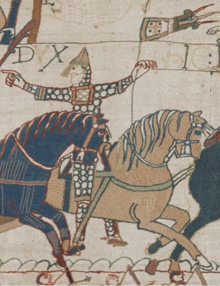Turstin FitzRolf
Turstin FitzRolf ( Turstin le Blanc, Turstin fitz Rou , † after 1086) was a Norman nobleman who played an important role in the Norman conquest of England . He is one of the 15 proven companions of William the Conqueror ( proven companions ) in the Battle of Hastings in 1066.
Name and origin
The part of the name "Fitz" means that Turstin was the son of Rolf or Rou, which corresponds to the Latinized Rollo . Turstin in turn comes from the Old Norse órstæinn ( Thorstein ; "Thor's stone") and is sometimes called Tosteins, Thurstan, Tostain u. a. written. In the Roman de Rou , Wace writes that Turstin comes from Bec-de-Mortagne in the Pays de Caux , Normandy:
Tosteins fitz Rou-le-Blanc out non,
Al Bec en Caux aveit meison
Turstin FitzRou the White was his name and lived
in Bec-en-Caux.
At the battle of Hastings
Ordericus Vitalis writes: " Turstinus filius Rollonis vexillum Normannorum portavit " ("Turstin, son of Rollo, carried the standard of the Normans."). These six words are worked out by Wace into a scene in which Turstin is also the one who carries the standard at the end.
It is sometimes assumed that Turstin is depicted on the Bayeux tapestry as the one carrying the standard, but the knight depicted seems to be more of Eustach II of Boulogne , especially since the preserved parts of the embroidery above E ... TIUS reveal , obviously "Eustatius", the Latinized form of Eustach. The figure is in conversation with Duke Wilhelm , points back and advises a retreat, as is also described by Wilhelm von Poitiers .
However, this is not certain, as Wilhelm von Poitiers does not designate Eustach as the standard bearer, while the otherwise convincing figure Eustatius in the tapestry clearly carries the apparently papal banner with a cross.
Succession
In the Domesday Book of 1086, Turstin is listed with numerous goods. He obviously had "relatives" and "heirs", as mentioned by Wace, but these are only likely to have been in Normandy, as there are no records of a family inheritance for his English possessions. Turstin is said to have had a son named Ralph (FitzTurstin) who moved to the Holy Land and died there.
Most of his property did not pass to his son - if he had one - but to the obviously unrelated Norman magnate Wynebald de Ballon , who served for a time as Seneschal at Caerleon Castle and was the brother of Hamelin de Ballon , the Builder of Abergavenny Castle . The reason for this transfer of ownership is unclear, whether it was due to Turstin's death or because he fell from the king and disfavor.
It is possible that after the death of the conqueror in 1087, Turstin stood on the side of the firstborn son Robert Curthose , who inherited it in Normandy, and against the younger son Wilhelm Rufus , who received the English crown. Turstin then found itself on the loser's side, as did Turstin's neighbors in Oakley, Gloucestershire , Gilbert fitz Turold and Roger de Lacy , both of whom were expelled in 1088.
swell
- Domesday Book ( online )
- David C. Douglas , GW Greenaway (Ed.) English Historical Documents 1042-1189, London, 1959.
- Ordericus Vitalis , Historia Ecclesiastica
Remarks
| personal data | |
|---|---|
| SURNAME | Turstin FitzRolf |
| ALTERNATIVE NAMES | Turstin fitz Rou; Turstin le Blanc |
| BRIEF DESCRIPTION | norman nobleman |
| DATE OF BIRTH | 11th century |
| DATE OF DEATH | after 1086 |
